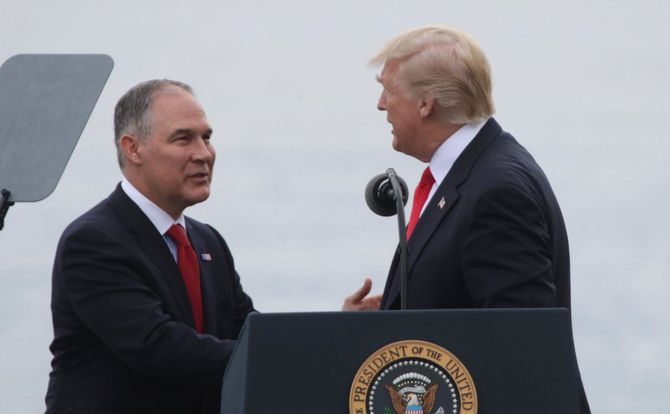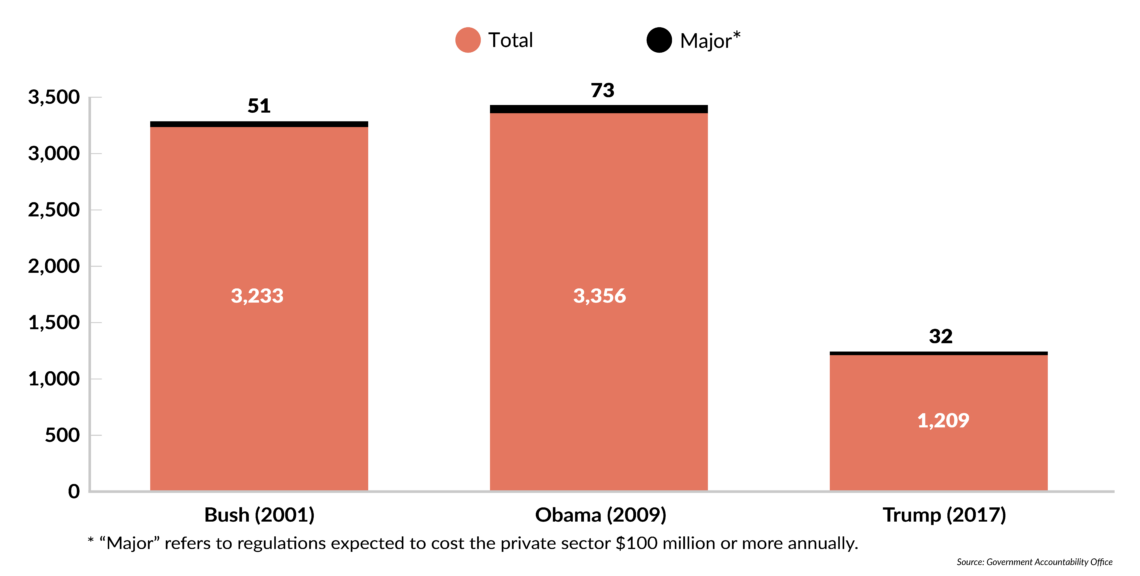Trump’s regulatory revolution
For all the sound and fury in the media over the Trump administration, there has been little recognition of the dramatic shift in regulatory policy over the past year. President Trump has ended many of his predecessor’s most burdensome rules on business and has slashed red tape.

In a nutshell
- President Trump has limited or eliminated many of the regulations implemented by his predecessor
- Changes that require more than executive power will be slow and painstaking
- His administration is built to continue this process
The media’s obsession with election conspiracies, dossier who-done-its, and geopolitical expletives (supposedly) muttered in private is overshadowing recognition of the dramatic shift in regulatory policy during United States President Donald Trump’s first year. There has been a virtual halt to his predecessor’s unparalleled rulemaking, and most of the signature regulatory initiatives implemented under former President Barack Obama (2009-2017) have been blocked or rescinded. By almost any standard, the pace of reform is impressive.
Candidate Trump repeatedly vowed to cut regulation “massively” and to “remove the anchor dragging us down.” Indeed, independent estimates peg the private-sector cost of U.S. regulation at more than $2 trillion annually – more than is collected in income taxes each year. The Obama Administration alone increased the nation’s regulatory burden by more than $122 billion annually. Combined with the red tape imposed during the administration of George W. Bush, regulatory costs have increased by at least $200 billion annually during the past 15 years.
The benefits of regulatory reform are numerous and well-documented. In a recent report on “The Growth Potential of Deregulation,” the Council of Economic Advisors conservatively estimated that excessive regulation cost the U.S. an average of 0.8 percent of gross domestic product (GDP) growth per year since 1980.
Challenging the status quo
The president’s authority to modify regulation is limited under the U.S. Constitution. The White House cannot countermand regulatory directives by Congress (although the president appoints agency heads who exercise latitude in rulemaking priorities). Presidents may guide agency action through executive orders, “guidance” documents and budgeting.
Excessive regulation has cost the U.S. an average of at least 0.8 percent of GDP growth per year since 1980.
Reform is hindered by the immensity, complexity and lethargy of the federal regulatory apparatus. A simple repeal requires adhering to a ream of administrative procedures, such as analyzing alternatives and presenting justification for public notice and comment. Litigation is rampant and protracted.
Ultimately, however, reform is painstaking because powerful forces favor the status quo. That is, regulation is a political spoils system by which various special interests impose their will on the public and profit from government favor. That makes the Trump administration’s regulatory efforts a struggle. Every way in which the White House presses its reform agenda challenges the legitimacy of the existing regulatory regime.
Regulatory rollback
President Trump is pursuing a multifaceted reform agenda. For example, has reversed his predecessor’s sweeping use of executive power by revoking the “guidance” dictating that transgender students have the right to use public restrooms that match their gender identity. The original directive from Obama’s Departments of Education and Justice lacked a legal foundation, and it can be argued that such matters are more properly addressed by states and local school districts.
Likewise, President Trump issued exemptions from President Obama’s far-reaching contraceptive mandate that required employers to offer health insurance coverage for all contraception approved by the Food and Drug Administration (FDA), including medications and devices that may act as abortifacients, as well as sterilization procedures.
As part of a broader effort to scale back President Obama’s substantial array of global warming programs, President Trump announced that the U.S. would withdraw from the Paris climate agreement, which President Obama had signed as an executive agreement on April 22, 2016.
Facts & figures
Regulations issued in U.S. presidents' first year

For purposes of steering regulatory policy, the president’s authority to appoint the heads of executive branch agencies (under the Appointments Clause of the Constitution) is among the most effective (although the power to dismiss imprudent administrators may be even more potent). Of particular significance was the appointment of Scott Pruitt as administrator of the Environmental Protection Agency (EPA).
Slashing red tape
Mr. Pruitt has proposed the repeal of the Clean Power Plan, the centerpiece of President Obama’s costly climate change initiative. He likewise is leading the effort to rescind Mr. Obama’s Waters of the United States rule, which imposed a new definition for the waters that the federal government can regulate under the Clean Water Act. The broad definition, if enacted, would infringe on property rights and override the role of states in water stewardship.
In addition to initiating a variety of other regulatory repeals, Mr. Pruitt halted the EPA’s manipulation of judicial review with a directive to end the agency’s “sue and settle” scheme. For years, EPA regulators worked in concert with advocacy groups to engineer legal settlements involving more stringent regulation than otherwise would have resulted from the formal rulemaking process. Similarly, Attorney General Jeff Sessions ended the Obama administration’s practice of funneling billions of dollars in settlement funds to left-wing allies.
Republican Ajit Pai, a career official of the Federal Communications Commission appointed by President Trump as its first Indian American administrator, also slashed red tape. The commission reversed the 2015 “net neutrality” rule (formally titled the Open Internet Order), which subjected internet service providers to regulations crafted decades ago for telephony.
Facts & figures
Efforts to limit regulation under previous presidents
Barack Obama
• Executive Order 13563 (2011)
Requires that new rules impose the least burden on society consistent with the regulation’s goals, and maximize net benefit. Also directs agencies to assess alternatives to regulation.
Requires that agencies develop a plan for the periodic review of existing regulations to determine what rules may be outmoded, ineffective, insufficient or excessively burdensome, and to modify, streamline, expand or repeal them as needed.
Bill Clinton
• Executive Order 12866 (1993)
Eased the rulemaking restriction established by Ronald Reagan’s administration that required regulatory agencies to find “that the benefits of the intended regulation justify its costs.” Also eliminated the authority of the Office of Information and Regulatory Affairs to halt a rulemaking or to require a demonstration that the benefits generated by a regulation exceed the costs imposed.
George H.W. Bush
• Council on Competitiveness (1989)
The council replaced Reagan’s Task Force on Regulatory Relief. It was authorized to review all federal regulations with the aim of eliminating those that inhibited U.S. competitiveness.
Ronald Reagan
• Executive Order 12291 (1981)
Established the Task Force on Regulatory Relief; required regulatory agencies to demonstrate that the benefits of a proposed regulation exceed the costs; and empowered the Office of Information and Regulatory Affairs to delay a rulemaking to ensure that broader economic issues were appropriately addressed by regulatory agencies prior to finalizing a new regulation.
Jimmy Carter
• Regulatory Analysis Review Group (1978)
Cabinet-level body granted review authority over important regulatory proposals. Composed of senior officials in the Office of Management and Budget, the Council of Economic Advisers, and the White House.
• Executive Order 12044 (1978)
Required all new major regulations (i.e., rules expected to impose costs on the private sector of $100 million or more annually) to undergo a Regulatory Analysis, including a description of the problem, an identification of alternative ways of achieving the policy goal, and an analysis of the potential economic impact of the regulation.
• Regulatory Council (1978)
Composed of representatives from 20 executive departments and 18 independent agencies with responsibility of preparing a semiannual schedule of proposed regulations as required by EO 12044.
Reining in the rules
The administration inherited 1,985 regulations in the rulemaking pipeline – 966 in the proposal stage and 1,019 in the final stage. The administration’s new Unified Agenda of Regulatory and Deregulatory Actions reflects the withdrawal of 635 previously listed rulemakings, another 244 regulations rendered inactive, and the delay of 700 rulemakings. The agenda also commits federal agencies to cutting future regulatory costs to the private sector by $9.8 billion.
Regulation is a political spoils system by which special interests profit from government favor.
Federal rulemaking slowed dramatically in 2017, with the Trump administration issuing two-thirds fewer regulations in its first year (1,209) than the administrations of both Presidents Barack Obama (3,356) and George W. Bush (3,233). The number of “major” rules, those anticipated to cost the private sector $100 million or more annually, numbered just 32 in President Trump’s first year, compared to 73 under President Obama and 51 under President Bush.
A great deal of credit for the regulatory respite belongs to lawyer and academic Neomi Rao, who President Trump appointed as head of the Office of Information and Regulatory Affairs. This office determines whether agencies have complied with rulemaking requirements, including risk assessments and cost-benefit analyses, and controls if or when a regulation is finalized.
In a radical departure from past regulatory practice, Ms. Rao characterized her agency’s approach to rulemaking as “cautious,” noting that the imposition of regulation must be authorized by statute, necessary to correct a substantial market failure, and of net benefit to the public.
Executive orders
The president has also issued a variety of executive orders (EOs) and presidential memoranda directing agency administrators to take specific regulatory actions. Signaling a major change in energy policy, for example, the president directed agency officials to expedite requests for approvals to construct and operate the Dakota Access pipeline, and to invite TransCanada to resubmit its application for construction and operation of the Keystone XL pipeline.
Two other executive orders are intended to have a direct and substantial impact on the extent of future rulemaking.
Past initiatives to prevent excess regulation have largely failed to reduce costs.
EO 13771 directs agency officials to identify for repeal at least two existing regulations for every new regulation they promulgate. (White House officials have raised the goal to eliminating three regulations for each new one issued.) The order also calls for a budgeting process to manage regulatory costs, and prohibits any increase in the total incremental cost of all regulations unless required by law or advised by the Director of the Office of Management and Budget.
The regulatory budgeting established in EO 13771 is intended to inject economic discipline and rationality into rulemaking. If agencies are compelled to restrict the costs imposed on the public, they must engage in a type of rolling retrospective review of the vast accumulation of rules that comprise more than 185,000 pages in the Code of Federal Regulation – up from some 138,000 in 2000.
From the administration of President Jimmy Carter (1977-1981) forward, agencies have been directed by the White House to conduct some form of regulatory look-back (see fact box). But absent a fixed numeric or budgetary target (as called for in President Trump’s order), there has been little accountability and thus past initiatives have largely failed to reduce regulatory costs.
Reform task forces
EO 13777 directs the head of each regulatory agency to designate a Regulatory Reform Officer to oversee the implementation of regulatory reform initiatives and policies within the agency. Under the order, each agency must establish a Regulatory Reform Task Force to evaluate regulations and recommend those appropriate for repeal, replacement, or modification. By directing agency staff to control costs, sound regulatory practices are internalized. (Also significant is the directive for agency heads to consider progress on reform in evaluating personnel performance.)
Creation of the regulatory task force is intended to broaden the search for regulations that 1) eliminate jobs or inhibit job creation; 2) are outdated, unnecessary or ineffective; 3) impose costs that exceed benefits; 4) are insufficiently transparent to meet the standard for reproducibility; or 5) implement executive orders and other presidential directives that have been subsequently rescinded or substantially modified.
More to come
As significant as President Trump’s actions have been to date, a great many reforms remain unfinished and numerous legal challenges are undecided. But the president is obviously undeterred, telling the World Economic Forum at Davos, Switzerland, “We have undertaken the most extensive regulatory reduction ever conceived.” Hyperbolic though that may sound, this administration has already delivered significant, tangible reforms and is certain to deliver more.






